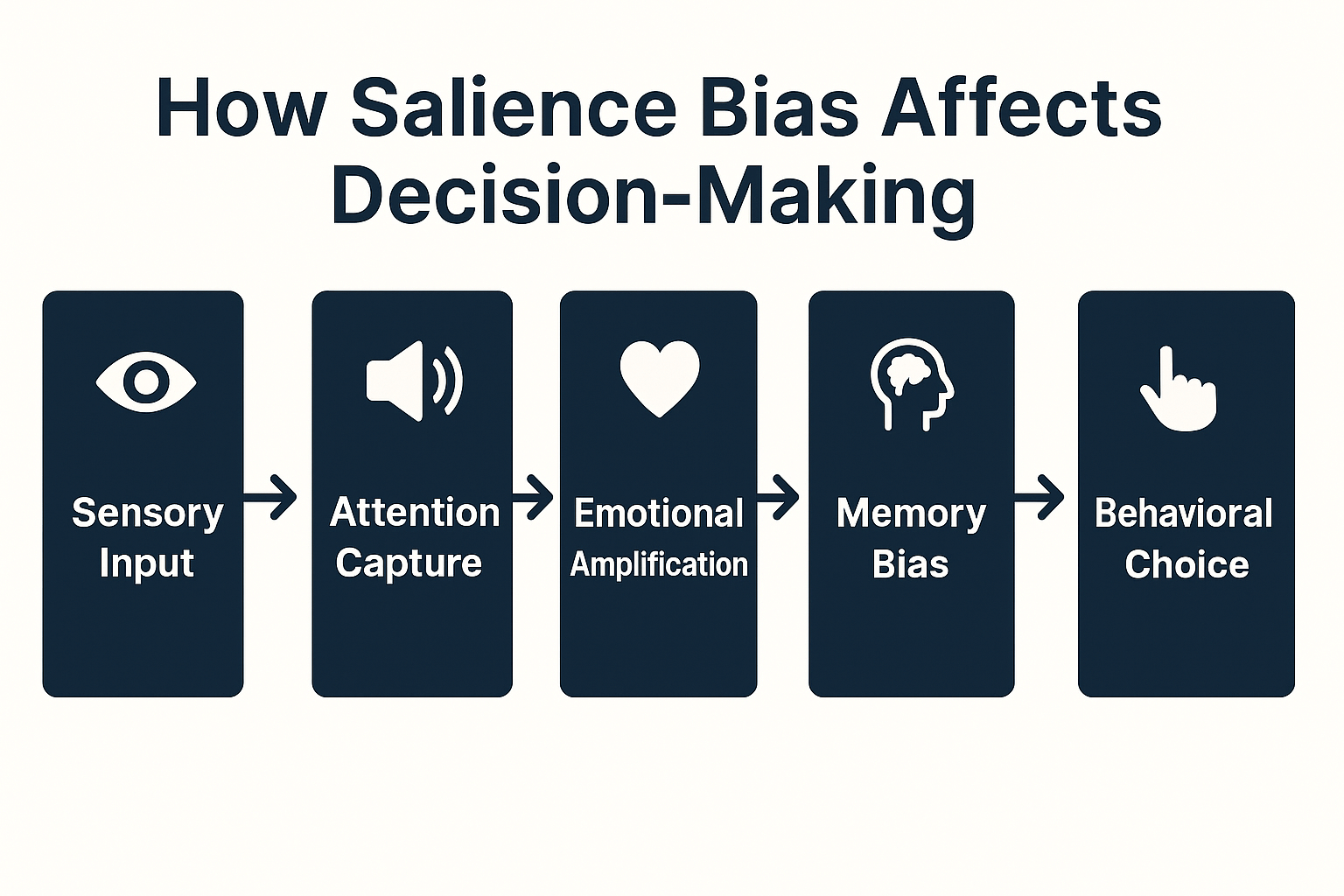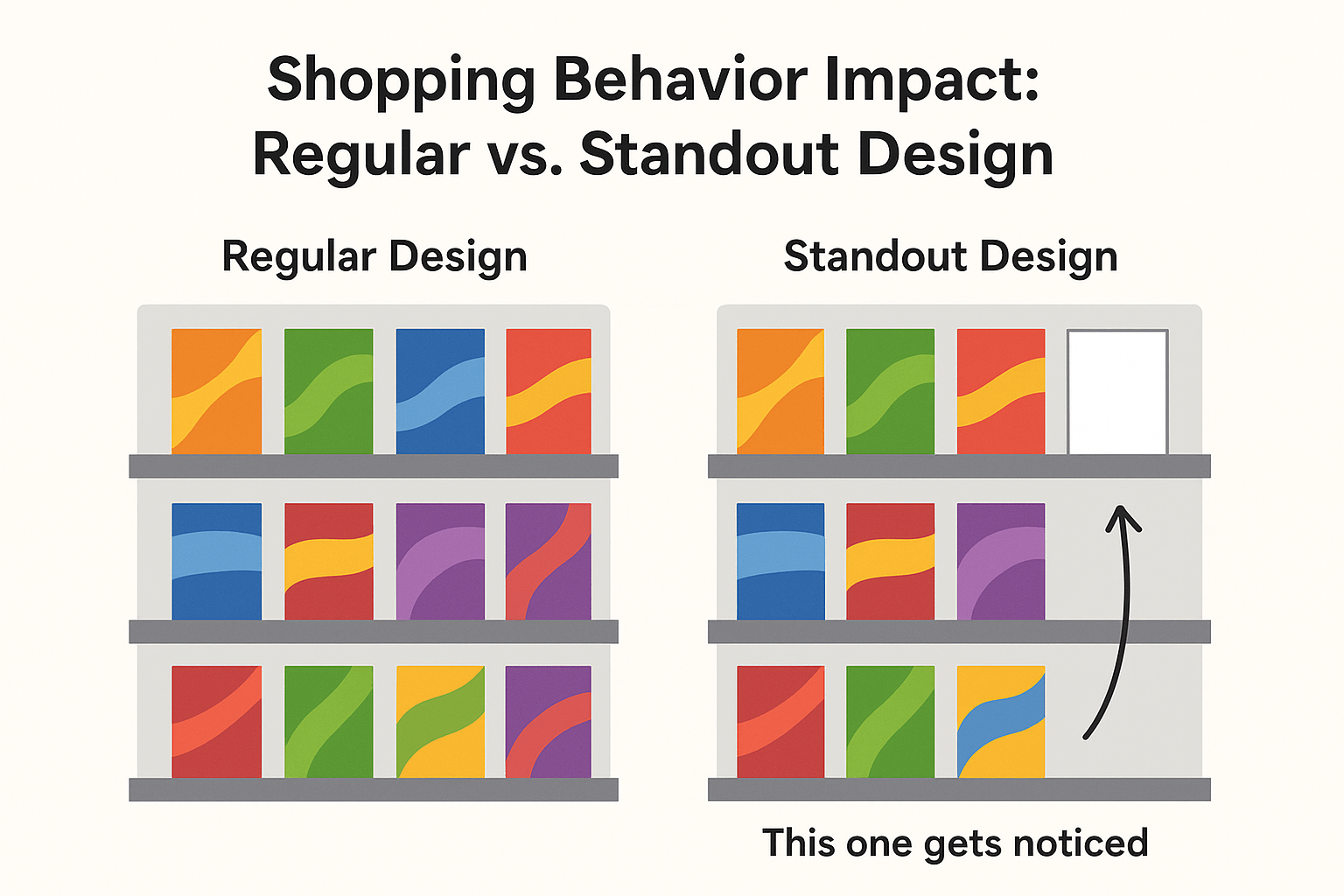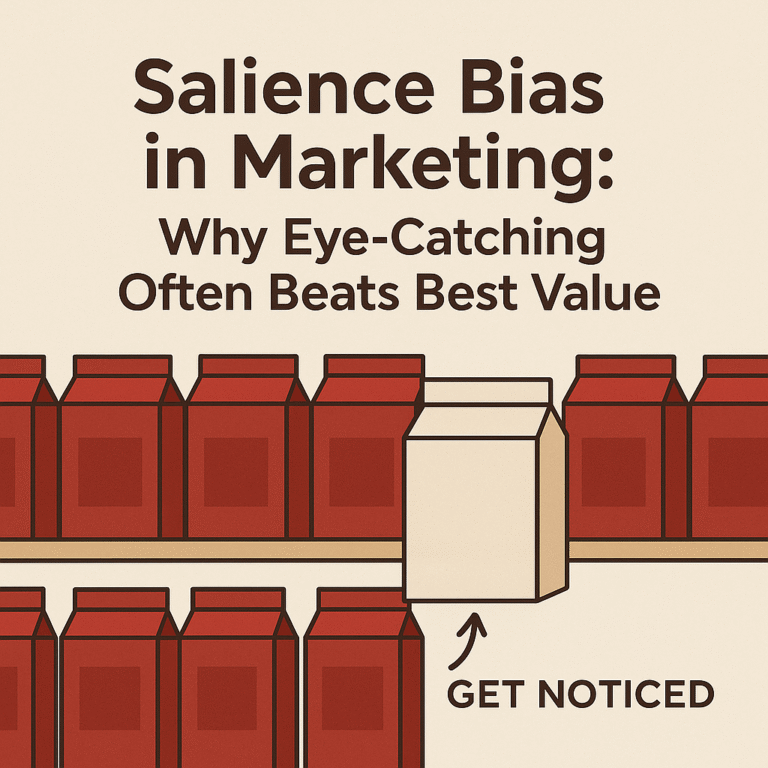Why do those flashy headlines stick with us while the more important facts fade away? And why are we often drawn to the eye-catching product over the one that offers better value? The answer lies in a powerful cognitive shortcut called salience bias.
Whether you’re a marketer, a consumer, or simply curious about how people make decisions, understanding salience bias offers a key insight: attention is a kind of currency, and we tend to spend it on what’s most visible, emotional, or unusual.
Let’s explore what this bias truly means, why it’s so significant, and how it shapes our behaviour in marketing, media, and everyday decision-making.
What Is Salience Bias?
Salience bias describes our brain’s inclination to prioritise prominent visual, emotional, or contextual elements while overlooking less obvious, yet potentially more significant, information.
In simpler terms, Things that grab our attention influence our decisions more heavily.
Why It Happens: The Psychology Behind Salience Bias

Salience bias isn’t something that just happens; it’s deeply connected to how our brains evolved to process information. Historically, early humans needed to quickly notice and respond to unusual or emotionally charged elements in their surroundings, which were often uncertain and dangerous. This survival instinct continues to shape how we pay attention today, often operating without conscious awareness.
| Psychological Mechanisms Behind Salience Bias | |||
|---|---|---|---|
| Psychological Mechanism | Description | Behavioral Expression | Marketing Implication |
| Selective Attention | The brain filters stimuli to prioritise the most noticeable or relevant ones. | People notice what stands out (e.g., bright colours, loud sounds). | Use high-contrast visuals and layout to direct user focus. |
| Cognitive Ease (Heuristics) | We prefer information that is easier to process and understand. | Quick decisions based on familiarity or obvious visual cues. | Simplify layouts, emphasise key benefits, reduce cognitive friction. |
| Emotional Tagging | Emotionally charged stimuli are more likely to be remembered and trusted. | Strong reaction to emotional storytelling or imagery. | Use relatable narratives and visuals to build a connection and recall. |
| Contrast Effect / Novelty Bias | The brain is attuned to notice deviations from patterns. | Items that “break the mould” get more attention. | Position products with unique shapes, colours, or placement strategies. |
| Social and Cultural Conditioning | What’s salient depends on personal experience, culture, or role. | Experts notice different things from novices. | Customise content and messaging for segmented audience groups. |
Let’s break down the core psychological processes explaining salience bias:
1. Selective Attention and Sensory Prioritisation
Our attention is a valuable resource, and our brains have a fascinating way of managing it! They don’t treat every stimulus the same; instead, they create filters. Salient information, things that are bright, loud, emotionally charged, or unexpected, cuts through the noise, allowing it to stand out and take centre stage in our awareness.
This remarkable process is known as selective attention. It’s closely linked to the brainstem’s reticular activating system (RAS), which is vital in determining what captures our attention and what fades into the background.
Imagine you’re in a busy room and suddenly hear your name! Even if you weren’t initially focused, your brain quickly highlights that input because it holds personal significance, a classic example of a salience trigger!
2. Cognitive Ease and Mental Shortcuts (Heuristics)
Humans are naturally inclined toward efficiency rather than perfection. In our fast-paced world, we often lean on heuristics, handy mental shortcuts that help us make quick decisions by focusing on immediate, noticeable clues.
Salience bias occurs when the most striking feature is associated with value or relevance, even if it is not connected.
3. Emotional Tagging and Memory Encoding
Emotionally charged stimuli are often much more memorable and persuasive than neutral ones! The amygdala, the brain’s emotional processing hub, is pivotal in giving emotional weight to specific experiences or information, making them feel more “sticky.”
Neuroscience research shows that emotionally salient stimuli activate stronger neural responses in memory-related brain areas. This is precisely why dramatic headlines or tragic news stories resonate with us more deeply than dry statistics do!
4. Contrast Effect and Novelty Bias
Our brains are naturally tuned to notice contrast. We have an innate ability to spot what disrupts a pattern, be it visually, conceptually, or socially.
This phenomenon, known as the contrast effect, means we assess things not on their own but in relation to what’s around them. Salience often occurs when something stands out from the usual.
Imagine a sleek, minimalist product package in a busy aisle; it will attract more attention than something that fades into the background, even if it provides less information.
5. Social and Cultural Conditioning
Lastly, it’s important to recognise that salience isn’t just about biology; it’s also something we learn along the way.
What we find salient often mirrors our roles, identities, and the cultures we belong to. For instance, a fashion stylist keenly notices trends that others might overlook, while a cybersecurity expert may identify risks in a news story that go unnoticed by most.
This process, known as attentional tuning, highlights how our environment and experiences wonderfully shape what truly stands out to us.
Salience Bias Examples in Everyday Life
In Consumer Behaviour
Ever grabbed a snack just because the packaging looked fun, without even thinking about the nutritional value? That’s a classic example of salience bias! Those bright colours, bold fonts, and tempting images can easily distract us from what really matters.
For instance, picture this: you walk into a store ready to grab some oatmeal, but somehow you leave with a chocolate bar because its wrapper was so appealing! It stands out more, but that doesn’t mean it’s the more intelligent choice.
In News and Media
When we see news coverage of rare yet shocking events, such as shark attacks or plane crashes, it can make us feel like these incidents happen all the time, even if the statistics tell a different story. The dramatic nature of these stories tends to overshadow the real probabilities, which can lead to misunderstandings about the risks involved.
In Financial Decisions
Consider a “2-for-1” deal: even if you only need one item, the deal’s appeal might lead you to spend more than you originally intended. It’s not necessarily logic guiding your purchase; instead, the enticing appearance of a bargain creates a pull.
Salience Bias in Marketing and Branding
Understanding salience bias is a strategic advantage for marketers. It explains why certain products dominate shelf space, ads go viral, or campaigns drive recall and action, while others, often more objectively valuable, get overlooked.
What grabs attention drives consumer behaviour, regardless of rational analysis. Below are three key areas where salience bias plays a crucial role in marketing and branding.
Visual Design and Product Placement

In saturated markets, visual salience often dictates which product gets noticed and bought.
Key Applications:
- Contrast-based packaging:
- A plain white box in a sea of brightly colored packaging will automatically attract the eye.
- Matte vs. gloss, minimalism vs. chaos, all leverage contrast to stand out.
- Unexpected adjacencies:
- Placing a product in a non-obvious location (e.g., protein bars in the beauty aisle) disrupts shopper expectations and increases attention.
- This approach activates novelty bias, reinforcing memory and curiosity.
Consumers often don’t choose the “best” option; they choose the most noticeable one. Brands that understand contextual contrast can outshine even better-resourced competitors.
Emotional Triggers and Messaging
Salience isn’t just visual, it’s also emotional. Emotionally resonant messages are easier to remember, share, and act upon.
Emotional Salience Techniques:
- Human faces: Our brains are wired to recognise and emotionally respond to faces, especially those expressing emotion.
- Relatable storytelling: Narratives that reflect personal struggle, aspiration, or humour deepen engagement.
- Symbolic imagery: Colours, icons, and metaphors evoke immediate associations (e.g., green for eco-friendly, hearts for empathy).
Emotion increases neural encoding, meaning emotional ads are more likely to be remembered and influence future behaviour, even unconsciously.
Pricing Strategies and Sales Tactics
Price perception is a battlefield of salience. Consumers rarely calculate actual value, instead, they respond to what feels like a good deal.
Common Tactics That Leverage Salience Bias:
- Artificial price anchoring:
- Displaying a higher “original” price beside a lower sale price amplifies perceived savings.
- Even if the product was never sold at the higher price, the anchor still shapes perception.
- Attention-grabbing sale elements:
- Red tags, countdown timers, or “limited stock” labels trigger urgency.
- These elements draw immediate focus and prompt impulsive behaviour.
- Decoy pricing:
- Introducing a higher-priced, less attractive option can make the target product seem more desirable.
- This leverages salience through contrast in value presentation.
Want to learn more about how to apply the decoy piercing strategy?
Read our Full Article 👉 “The Decoy Effect: The Psychology Behind How We’re Tricked into “Better” Choices”
Pricing isn’t just math, it’s theatre. Make the discount look dramatic, and consumers will feel they’re getting more, even if the value is static.
How to Use Salience Bias in Marketing
Salience bias can be a fantastic ally in marketing when used with care! Rather than manipulating consumers, ethically applying this bias empowers individuals to make quicker, clearer, and more informed decisions in our bustling, noisy world.
Here’s how to do it the right way:
Make the Right Thing the Most Noticeable
Your product’s most valuable feature shouldn’t be buried in fine print.
What to do:
- Use visual contrast (colour, typography, spacing) to highlight benefits, not gimmicks.
- Design product pages, ads, and landing pages to draw the eye to core value propositions.
- On packaging, make ethical or sustainability claims prominent, not hidden.
Example: If you’re selling eco-friendly cleaning products, make the environmental certifications and “plant-based formula” claim the visual focal point.
Use Emotion to Reinforce, Not Distract
Emotion grabs attention. But if it’s disconnected from your actual offer, it becomes manipulative.
What to do:
- Use authentic customer stories or brand purpose to create emotional resonance.
- Avoid shock tactics or unrelated emotional cues that hijack attention without adding meaning.
- Align emotional triggers with the customer’s goals or values, not just brand visibility.
Example: A wellness brand could share a customer’s transformation journey rather than showing an exaggerated before-and-after image.
Design for Decision Simplicity
When everything is competing for attention, clarity wins.
What to do:
- Eliminate cognitive overload: focus on one clear CTA per screen or section.
- Use icons, infographics, and layout hierarchy to naturally guide the user’s eyes.
- Show comparisons side-by-side to highlight your product’s standout advantages.
Example: If offering a subscription service, highlight the “Most Popular Plan” with subtle emphasis, such as a border, icon, or label, to make the choice easier, not forced.
Create Positive Feedback Loops
Make progress and good behaviour visible. Salience bias can reinforce engagement and loyalty.
What to do:
- Show progress bars (e.g., towards free shipping or loyalty rewards).
- Give visual cues for impact (e.g., “You’ve saved 12kg of CO₂ this month”).
- Use real-time alerts, gamification, or visual milestones to make positive action salient.
Example: A budgeting app could use colourful indicators and savings animations to motivate users.
| Marketing Applications of Salience Bias | ||
|---|---|---|
| Marketing Area | Practical Techniques | Goal / Effect |
| Visual Design & Product Placement | – Use colour contrast and minimalist packaging – Place products in surprising locations |
Capture visual attention and trigger curiosity |
| Emotional Triggers & Messaging | – Include human faces – Use storytelling – Leverage symbolic imagery |
Strengthen emotional connection and increase message retention |
| Pricing Strategies & Sales Tactics | – Show “original vs. discounted” price – Use urgency signals – Implement decoy pricing |
Make offers feel more valuable and prompt immediate action |
| UX and Decision Simplicity | – Highlight key CTAs – Provide side-by-side comparisons – Use progress indicators |
Help consumers make faster and clearer decisions |
| Post-Purchase Engagement | – Show progress (e.g., points earned) – Use visual milestones or achievements |
Reinforce positive behaviour and encourage loyalty |
Conclusion
Salience bias isn’t just a psychological curiosity; it’s a powerful tool that marketers can ethically use to elevate the right message, product, or action! Understanding what grabs attention and why allows you to create campaigns that resonate, convert, and build lasting trust.
Whether focusing on a value proposition, designing eye-catching packaging, or crafting an engaging email subject line, remember that clarity and contrast win in a world full of noise!
FAQ
Salience bias is a cognitive tendency that leads individuals to prioritise the most noticeable, emotionally impactful, or eye-catching information while overlooking subtler yet possibly more significant details. This bias influences our perception of the world and decision-making processes, often unconsciously.
In marketing, this illustrates why consumers may opt for a product with eye-catching packaging rather than a more economical option, primarily due to its prominent appearance.
– Choosing a snack based on colourful packaging rather than nutrition
– Reacting strongly to shocking news despite low statistical risk
– Responding to “50% OFF” signs even if you didn’t intend to shop
– Highlight true benefits, not superficial hype
– Use contrast, colour, and placement to guide, not manipulate, attention
– Reinforce important messages (e.g., sustainability, impact, value)
– Avoid misleading pricing or urgency tactics

